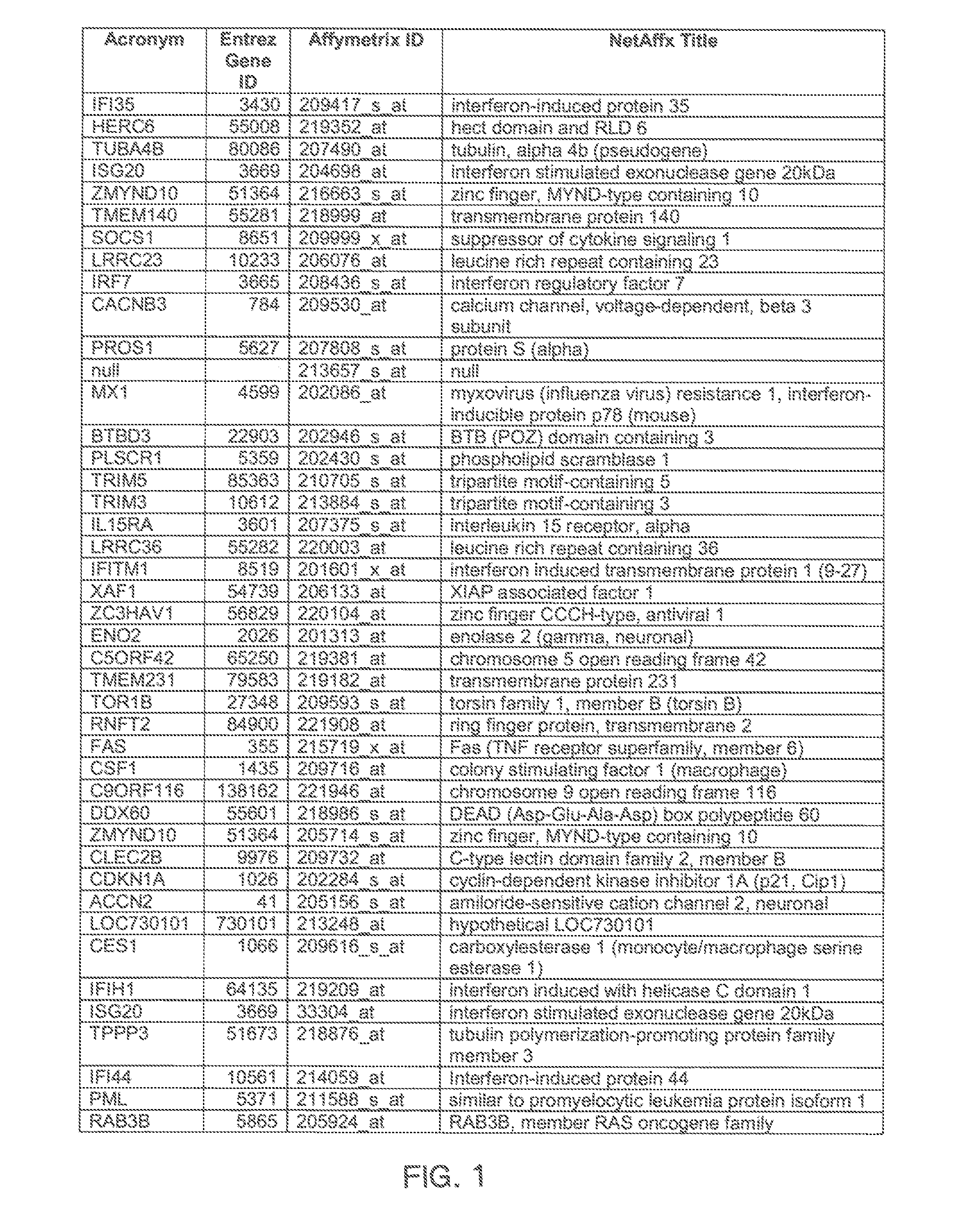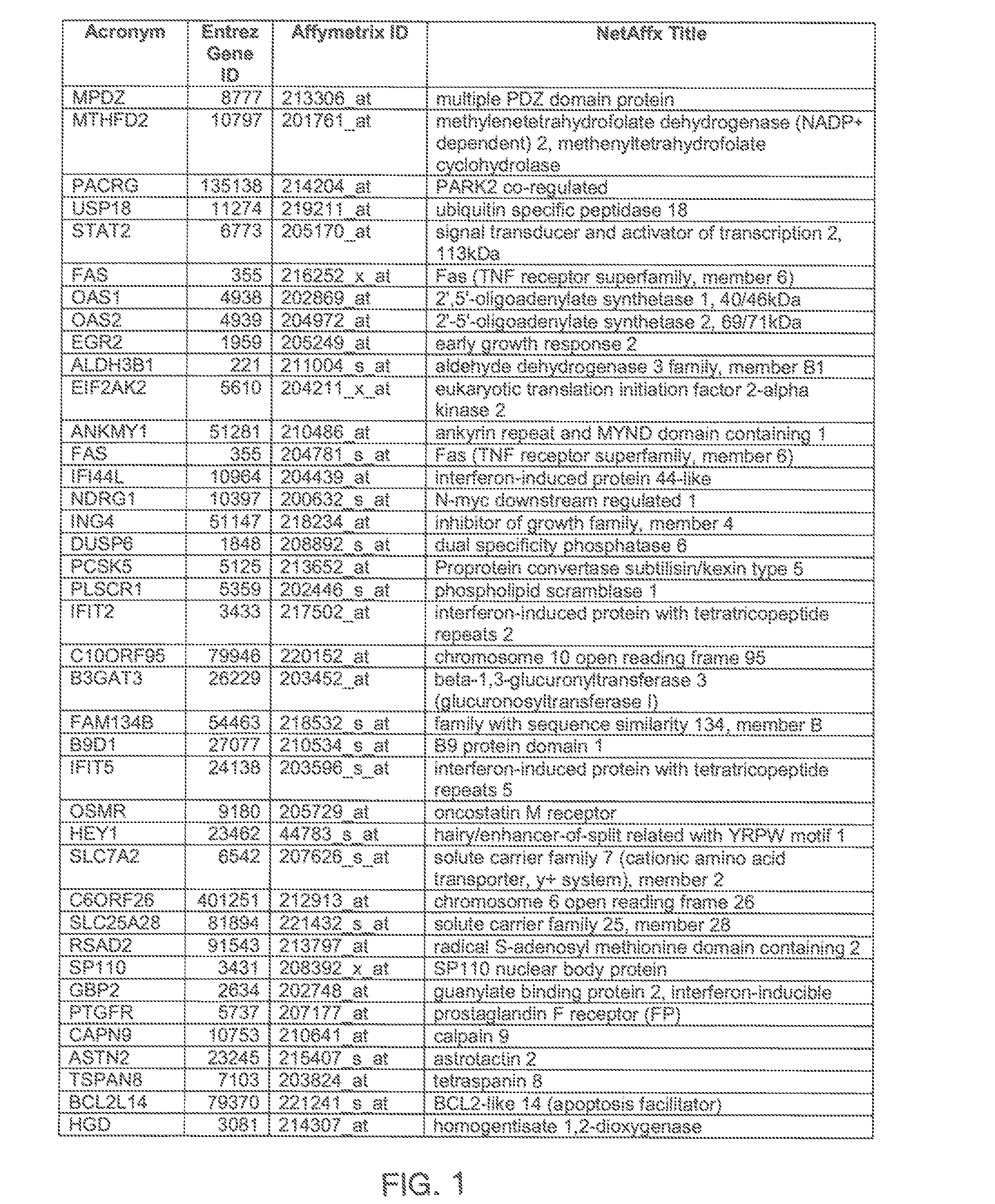Methods for Detecting and Treating Rhinovirus Infection
a technology of rhinovirus and rhinovirus, applied in the field of gene expression profiles, can solve the problems of affecting the effective treatment of patients, the difficulty of distinguishing rhinovirus-based respiratory symptoms from other respiratory ailments, etc., and achieve the effects of improving respiratory health, maintaining or improving respiratory health, and improving respiratory health
- Summary
- Abstract
- Description
- Claims
- Application Information
AI Technical Summary
Benefits of technology
Problems solved by technology
Method used
Image
Examples
example 1
[0096]Gene expression was assessed by microarray analysis of polynucleotides isolated from nasal scrapings obtained from subjects before and during experimental infections with human rhinovirus 16 (HRV-16) as described in Proud et al., Am. J. Respir. Crit. Care Med., 178, 962-968 (2008). Briefly, one group of individuals was inoculated with HRV-16, and a control group of individuals were shaminoculated. Nasal epithelial scrapings were collected from alternating nostrils 14 days prior to inoculation, eight hours post-innoculation, and 48 hours post-innoculation. Total RNA was extracted from nasal scrapings with TRIzol reagent (Invitrogen) and purified using RNeasy columns (Qiagen). RNA was quantitated using microarray chips (Affymetrix) comprising probes for more than 47,000 transcripts.
[0097]Analysis of covariance (ANCOVA) statistical analysis, a cut-off based on fold change in expression, and weighted voting algorithms with a cross model validation model were used to identify a hig...
example 2
[0102]This example describes a method of using a gene panel for human rhinovirus infection and a pattern matching approach to identify candidate agents for maintaining or improving respiratory health.
[0103]The gene panel identified in Example 1 was used to query databases comprising gene expression profile data obtained from cells exposed to chemical compounds to identify compounds that share a reverse expression pattern (i.e., a “negative connectivity”) with the gene expression profile determined from rhinovirus infected patients.
[0104]The following compounds were identified (connectivity score provided in parentheses): fisetin (−0.968), splitomicin (−0.926), phenyl biguanide (−0.924), beclometasone (−0.905), tomelukast (−0.901), flupentixol (−0.874), decitabine (−0.862), topiramate (−0.855), tiabendazole (−0.819), pirlindole (−0.818), pancuronium bromide (−0.801), metaraminol (−0.787), yohimbic acid (−0.783), arachidonic acid (−0.748), myosmine (−0.74), proscillaridin (−0.736), na...
example 3
[0108]A composition comprising an excipient identified as described herein is prepared as follows:
Analgesic / Anti-inflammatory / Anti-Decon-Anti-ExampleExcipientAntipyretictussivegestanthistamineFormulation(M)(M)(M)(M)(M)11-10300.020.0010.521-10300.020.001x31-10300.0220.541-10300.022x51-10250.020.0010.561-10250.020.001x71-10250.0220.581-10250.022x
[0109]Suitable excipients, analgesics / anti-inflammatories / antipyretics, antitussives, decongestants, and antihistamines are described herein. Various exemplary formulations of the invention comprise ibuprofen (formations 1-4) or acetaminophen (formulations 5-8), dextromethorphan, phenylephrine (formations 1, 2, 5, and 6) or pseudoephedrine (formations 3, 4, 7, and 8), dexamethasone, and / or doxylamine. Alternatively, the decongestant is oxymetazoline (1 M). In various embodiments, the excipient is a flavonoid and / or anti-oxidant, such as quercetin (2 M), neohesperidin (3 M), propyl gallate (2 M), quercetin+neohesperidin+propyl gallate, naringen...
PUM
| Property | Measurement | Unit |
|---|---|---|
| temperature | aaaaa | aaaaa |
| Shear Viscosity Method | aaaaa | aaaaa |
| Shear Viscosity Method | aaaaa | aaaaa |
Abstract
Description
Claims
Application Information
 Login to View More
Login to View More - R&D
- Intellectual Property
- Life Sciences
- Materials
- Tech Scout
- Unparalleled Data Quality
- Higher Quality Content
- 60% Fewer Hallucinations
Browse by: Latest US Patents, China's latest patents, Technical Efficacy Thesaurus, Application Domain, Technology Topic, Popular Technical Reports.
© 2025 PatSnap. All rights reserved.Legal|Privacy policy|Modern Slavery Act Transparency Statement|Sitemap|About US| Contact US: help@patsnap.com



